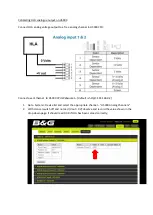
4-1
39020-02 08/16
VERSALIFT VST-39/43/50/55-TN
OPERA
TION
This chapter provides operators and ground crew with
recommended aerial lift operating procedures,
descriptions and detailed operating information about
the controls at each control station. Operators and
ground crews are responsible for knowing and applying
this information to job site situations.
Only properly trained operators are qualified to operate
the
Versalift
aerial lift. Operator training shall include
complete instruction and understanding of the
manufacturer’s manuals, employer’s work rules, and
all related governmental regulations. Prior to operation
from the platform the machine must be operating
properly, must have been installed properly, inspected,
and maintained in accordance with the manufacturer’s
instructions. All safety signs, guards, and covers must
be in place and in proper condition.
DANGER:
AN UNTRAINED OR
CARELESS OPERATOR SUBJECTS HIM/
HERSELF AND OTHERS TO DEATH OR SERIOUS
INJURY.
It is the responsibility of the operator and ground crew
to make certain that the identification, operation, and
instructional decals are not lost, damaged, or illegible.
If these conditions exist the decals must be replaced
before lift operation. Refer to the Decal Placement
illustration in Section 6 of this manual for decal location
and parts listing.
POSITIONING THE VERSALIFT FOR
OPERATION
This section describes proper positioning of the
Versalift aerial lift so that it will be as stable and useful
as possible. The information in this section includes
orientation of the truck at the work site, a checklist of
responsibilities before leaving the truck cab,
requirements after leaving the truck cab, and engaging
the outriggers.
ORIENTING THE TRUCK AT THE WORK SITE
- Be
sure to park the truck on firm level ground. Do not
operate the Versalift unit on a slope greater than 5
degrees (1 foot rise in 12 feet) on units not equipped
with outriggers. On units with outriggers, aerial device
OPERATION
must be leveled within 2° of horizontal prior to
operation. Refer to slope indicators provided on the
chassis to show whether the aerial device is positioned
within limits permitted. Slope reduces the vehicle’s
stability and places additional stress on the lift and
components. Maintaining the correct tire pressure
and engaging the outriggers (if so equipped) contribute
to vehicle stability. Refer to the subtitle “Outriggers”
in this section for further details on engaging the
outriggers. If there is any doubt about vehicle stability
under any condition, do not operate the lift.
DANGER:
NEVER OPERATE THE
LIFT ON A SLOPE GREATER THAN 5
o
. WITHOUT
PROPER STABILITY THE UNIT MAY TIP
RESULTING IN DEATH OR SERIOUS INJURY.
RESPONSIBILITIES BEFORE LEAVING THE
TRUCK CAB -
Perform the following steps in preparing
to operate the aerial-lift. It is assumed that the truck
engine is still running. However, if the lift hydraulics
are powered by an auxiliary engine (optional power
unit) then it is not necessary for the truck engine to
remain running.
1.
Set the parking brake and the brake lock (if so
equipped).
2.
Shift the truck transmission into neutral (manual
transmission) or park (automatic transmission) .
3.
Turn on the warning light flashers.
4.
Depress the clutch and engage the PTO, if so
equipped.
5.
Activate the master control with the toggle switch
on the truck dashboard. A red light next to the
toggle switch on the dashboard indicates when
the master control system is energized. The truck
ignition must be on unless equipped with an
auxiliary engine.
REQUIREMENTS AFTER LEAVING THE TRUCK
CAB:
1.
Check wind and weather conditions. Do not
operate the platform if wind gust exceeds 30 mph
(48 km/hr) or there is a threat of an electrical storm.
2.
After leaving the cab chock the wheels. This is
extremely important because the brake systems
on some larger trucks have a critical weakness.
They may be engaged by locking the drive shaft
PRIOR TO OPERATING THE AERIAL LIFT,
REFER TO “DAILY VISUAL INSPECTION”,
SECTION 6 OF THIS MANUAL. DAILY VISUAL
INSPECTION MUST BE PERFORMED
BEFORE OPERATING THE LIFT.
Summary of Contents for VST-39-TN
Page 2: ......
Page 4: ......
Page 6: ......
Page 11: ...2 3 39020 02 08 16 VERSALIFT VST 39 43 50 55 TN RESPONSIBILITIES SAFETY ...
Page 12: ...2 4 RESPONSIBILITIES SAFETY 39020 02 08 16 VERSALIFT VST 39 43 50 55 TN ...
Page 16: ......
Page 24: ...3 8 39020 02 08 16 VERSALIFT VST 39 43 50 55 TN SPECIFICATIONS ...
Page 25: ...3 9 39020 02 08 16 VERSALIFT VST 39 43 50 55 TN SPECIFICATIONS ...
Page 26: ...3 10 39020 02 08 16 VERSALIFT VST 39 43 50 55 TN SPECIFICATIONS ...
Page 27: ...3 11 39020 02 08 16 VERSALIFT VST 39 43 50 55 TN SPECIFICATIONS ...
Page 28: ...3 12 39020 02 08 16 VERSALIFT VST 39 43 50 55 TN SPECIFICATIONS ...
Page 29: ...3 13 39020 02 08 16 VERSALIFT VST 39 43 50 55 TN SPECIFICATIONS ...
Page 32: ...3 16 39020 02 08 16 VERSALIFT VST 39 43 50 55 TN SPECIFICATIONS ...
Page 33: ...3 17 39020 02 08 16 VERSALIFT VST 39 43 50 55 TN SPECIFICATIONS ...
Page 34: ......
Page 46: ......
Page 54: ...6 4 39020 02 08 16 VERSALIFT VST 39 43 50 55 TN DAILY VISUAL INSPECTION ...
Page 55: ...6 5 39020 02 08 16 VERSALIFT VST 39 43 50 55 TN DAILY VISUAL INSPECTION ...
















































